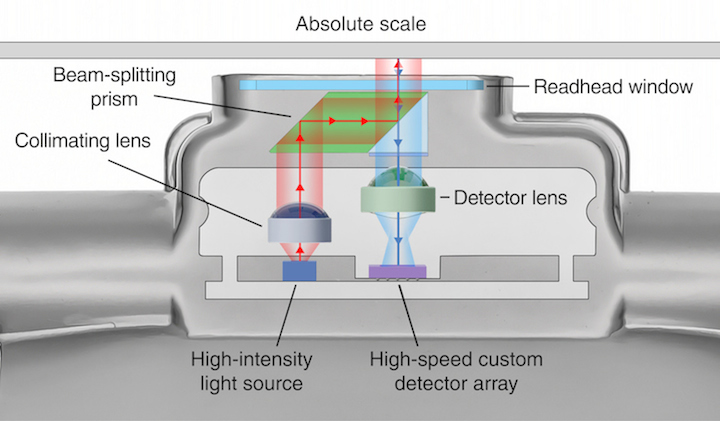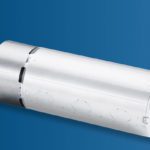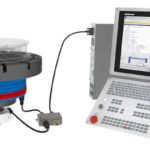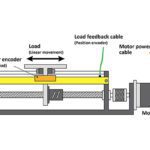Encoders are central to motion control applications, providing feedback in order to increase system accuracy and reliability. As other components in motion systems evolve, encoder manufacturers are making sure that their offerings keep pace with these broader technological changes.
For instance, the rise in high-performance networks for motion control is in part driven by the increased power of controllers, especially PLCs. These changes in turn have been propelled by the rise in more sophisticated automation systems.
As Christian Fell, Head of Posital’s North American operations and Director of Technology for Posital’s parent company, Fraba B.V., puts it, “we have responded by continuously upgrading our product portfolio to offer more connectivity options and to deliver enhancements such as self-diagnosis and programmability.” He points out how this combination is synergistic. “Networks based on high-performance industrial Ethernet such as Ethernet IP or ProfiNet can be used to collect sensor data in real time, while also enabling operators to fine-tune their sensors’ performance characteristics by adjusting software parameters. IO-Link is an example of a flexible communications protocol that is simple to implement, but powerful in terms of encoder setup.”
Howard Salt, Senior Business Manager of Encoder Systems at Renishaw, sees a similar situation with regards to networking, and along with that more interest in functional safety. “While we work with our customers individually, functional safety (SIL) is an area which we’re concentrating on to ensure international certification and that we deliver the safest encoders on the market,” notes Salt. “Suppliers can be intent on delivering some of the most technically advanced encoders in the market, but they’ve got be reliable and safe too.”
Along similar lines, designers are showing more interest in modular and user-formatted or custom designed encoder offerings. As Salt notes, “many manufacturers don’t want their designs hampered by traditional off the shelf encoder packages. Something we’ve developed to help customers in this process is a “knowledge center” on our magnetic encoder web site, where engineers can directly interface with our design engineers to design or modify encoder platforms to their OEM requirements.”

Posital’s Christian Fell concurs, noting that the company’s encoders have a modular design, making it easier to meet a wide range of their customer’s requirements. “A modular approach is also evident in our ‘kit encoders’ – lower-cost unbundled versions of our electronic packages that can be built into customers’ products without requiring separate housings, shafts, and bearings,” notes Fell, adding that “many of our products are field-programmable, so that customers can fine-tune performance characteristics by modifying software parameters. This has been especially popular with incremental encoders, where our customers can set the resolution (pulses per rotation) and communications interface characteristics they need with simple firmware updates.”
Such flexibility is an asset, especially when it comes to satisfying the needs of customers in new application areas. For Posital, “an area that is changing more rapidly is mobile machinery, where there is growing interest in automated and/or remote-control systems for off-road vehicles, agricultural machinery and construction equipment,” says Fell. AGV and other automated mobile robots are also a growth area. “For floor cleaning machines, for example, demand is being fed by advances in autonomous guidance systems, combined with a COVID-driven need for more frequent cleaning cycles and less worker exposure. Encoders and other position sensors are used in these machines to provide feedback to the guidance systems on steering angle, wheel rotation and the location of various actuators.”
Renishaw is seeing similar trends, with robotics a growth industry. As Howard Salt notes, “agriculture is becoming more automated, as are off-highway and autonomous vehicles of course. Medical robotics is a large growth area as well.” And growth in these areas “brings with it the increased requirements for us to deliver reliable, safe product – often with short notice.” This is where vertical integration, along with equipment designers working hand-in-hand with production engineers, designing custom ASICs for instance, all help the company manage increasing demand and demand spikes.
A large contributor to variability of demand has been the coronavirus pandemic, which has impacted businesses in varying ways. “We see uncertainty in the business environment, causing customers to shorten their planning horizons,” says Christian Fell of Posital. “This has meant some reduction in long-term, high-volume orders,” continues Fell, but “Posital’s build-to-order manufacturing model is well positioned to respond to shorter production cycles.”

Manufacturers also took the time to re-think their own manufacturing processes as well as how best to support customers. As Renishaw’s Howard Salt remarks, “Like many manufacturers, our manufacturing and support groups needed to re-think and reorganize assembly cells and machine shops to ensure safety and social distancing. This took some time, however the new working conditions and increased production capabilities resulted in us being capable of meeting demand cycles.”
The pandemic has also brought into sharp focus the importance of the internet and online design tools. These can include product selectors with access to data sheets or 3D CAD models, as well as more one-on-one support. Christian Fell mentions one of Posital’s recent online offerings, an Encoder Match tool, “that allows customers to find replacements for older incremental encoders, based on manufacturer name and model number. This is aimed at the MRO market and is intended to identify a Posital product that is functionally equivalent to older devices – regardless of the original manufacturer.”
For Renishaw, Howard Salt remarks: “We find that having regional engineering support across the country with a direct “hot line” to our design and production engineers is extremely important. Renishaw engineers are able to work with our customer’s engineers, select, modify or in some cases, design encoders to suit their applications. Sure, we use CRM and design software packages; however, we still find “engineer to engineer” (often under NDA) discussions much more powerful and timely, especially when discussing new designs.”






Leave a Reply
You must be logged in to post a comment.